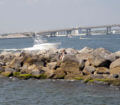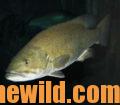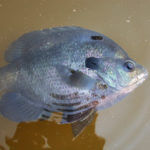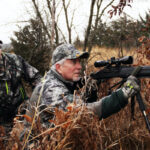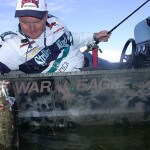John’s Note: You’ll probably have the most fishing success at the Gulf of Mexico fishing around Alabama Point and the back-bay areas on Alabama’s Gulf Coast. Even in bad weather when the charter boats can’t go out, you still can catch a mess of fish in the region around Perdido Pass. I know of one time that a charter boat with 12 fishermen on-board blew an engine on the way out to snapper fish. By the time they arrived back to the dock, half their fishing day was already gone. But the 12 fishermen got on four inshore boats and fished around Alabama Point, where for instance only two anglers caught 76 pounds of redfish, speckled trout and flounder. The fishermen actually brought more fish to the dock than they would have caught if they’d gone out to deep water.
Although some anglers who fish the jetties catch and release fish, a greater percentage of the anglers fishing the jetties want to catch a meal of fresh fish for the table, including pompano, sheepshead, redfish, speckled trout and flounder. When you fish the jetties at Alabama Point, you really don’t know what type of fish you may catch. Fishing light line, a small shot lead 15- to 20-inches up the line, a No. 8 treble hook and live shrimp for bait, you’ll take a wide variety of good-eating saltwater fish at Alabama Point. Because so-many species of fish concentrate at Alabama Point, even if one type of fish doesn’t bite, you’ll generally find another species biting. According to Karon Aplin, a fisheries biologist with the Alabama Marine Resources Division, anglers catch Spanish mackerel too at Alabama Point.
 Captain Keith Powell at Zeke’s Landing in Orange Beach, Alabama emphasizes that, “If an angler wants to catch what’s biting, Perdido Pass at Orange Beach is hard to beat, because not only can we fish in front of and behind the bridge pilings at Perdido Pass Bridge, once we fish there, we can go fish the jetties on the east side of the pass. A couple of big holes there historically hold redfish, flounder and sometimes pompano, particularly in the fall. Then we can go over to the jetties on the west side of Perdido Pass and drift down the jetties with bull minnows or live shrimp. Often we’ll catch big speckled trout, flounder and an occasional redfish there. The one thing you can bet on is you can catch some kind of fish almost every day when you fish around Perdido Pass. For more information, contact Zeke’s Landing at http://www.zekeslanding.com/ or 1-800-793-4044.
Captain Keith Powell at Zeke’s Landing in Orange Beach, Alabama emphasizes that, “If an angler wants to catch what’s biting, Perdido Pass at Orange Beach is hard to beat, because not only can we fish in front of and behind the bridge pilings at Perdido Pass Bridge, once we fish there, we can go fish the jetties on the east side of the pass. A couple of big holes there historically hold redfish, flounder and sometimes pompano, particularly in the fall. Then we can go over to the jetties on the west side of Perdido Pass and drift down the jetties with bull minnows or live shrimp. Often we’ll catch big speckled trout, flounder and an occasional redfish there. The one thing you can bet on is you can catch some kind of fish almost every day when you fish around Perdido Pass. For more information, contact Zeke’s Landing at http://www.zekeslanding.com/ or 1-800-793-4044.
What Makes Alabama Point Good for Fishing:
The large rocky boulders forming the jetties hold a wide variety of fish species and provide an endless sea of baitfish for the predator fish. As most anglers know, current causes fish to bite. On an outgoing tide, the current comes from the back bays out through the jetties. On an incoming tide, the current moves from the Gulf of Mexico and flows into the back bays. But often the jetties won’t have any incoming or outgoing tides bringing the current through the jetties for 1 to 2 hours. Besides the rocks that make up the jetties, a concrete wall runs from the jetties toward the shore. The east jetty homes two deep holes. At the points of both the east and the west jetties, you’ll find calmer current and often a back-current on either side of the jetties. The inside of the mouths of the jetties includes the Alabama Point Bridge, which breaks the current and provides habitat for a wide variety of saltwater fish. Then in the back bays, you’ll find shallow grass and small holes that will hide fish. When you fish at Alabama Point, you’ll have a wide variety of structure that will hold fish, regardless of wind and weather conditions.
Speckled Trout:
To take speckled trout, many anglers like to go to the break in the concrete wall, which will be on the outside on the east jetty. The old, underwater seawall is broken-up there, and a strong current flows through that break in the wall. Fishermen there use live shrimp, live croakers or live LYs (alewives) primarily with 10- to 20-pound-test monofilament line. Using a spinning rod, anglers on the jetties generally fish with no bobber, put a split shot 18- to 20-inches up the line, use a No. 8 treble hook, hook the live shrimp under the horn as far as away from the black spot, which is its brain, as possible, cast into the current or upcurrent from the crack in the wall and let the shrimp wash through the break in the wall. The less weight you use on the line to get the shrimp down near the bottom, the more strikes you’ll get. Just as the shrimp passes over the rock pile in the break in the wall, you can expect to get a bite. The trout usually will hold behind the rocks and out of the current and then move into the current to feed. You also can catch speckled trout by going out of the pass about 3/4 of the way down the west jetty – about 75- to 80-yards north of the tip of the west jetty. A deep hole is there, and the rocks run out a little further than they do anywhere else on the jetty. Historically, trout have held in that spot.
“Two of my favorite places to catch redfish are the end of the east jetty and the channel under the bridge,” David Brown of Brown’s Inshore Guide Service at Orange Beach Marina in Orange Beach, Ala., reports. “You’ll find lots of rocks on the east jetty and the point on the west jetty. Often if the redfish aren’t biting in the deep hole at the end of the east jetty, you can catch them shallow on the west jetty. Many anglers throw out past where the redfish are holding, if they’re fishing from the jetties. I’ll try and pull my boat in close enough to cast within 3 to 4 feet of the rocks on the west jetty and let my live shrimp drift down. I’ll often find the redfish in that shallow water close to the jetty. Too, a rock pile lays inside the pass on the southeast corner of the east jetty. One of my favorite places to fish inside the pass about 50-yards from the tip of the east jetty is on a small rock pile that concentrates redfish. I’ll also get behind the bridge pilings on the edge of the channel, cast upcurrent with my live shrimp and try and let my bait wash down the edge of the channel and into the eddy water behind the pilings. Besides redfish, you’ll take pompano, flounder and speckled trout in this same area.”
Flounder:
“Too, you can catch flounder in any of the places where I fish for speckled trout and redfish,” Brown reports. “But I usually come into the bay and fish around boat docks for flounder. Since the flounder generally will be facing upcurrent, I’ll cast my live shrimp upcurrent and let it drift toward the pilings of the dock. Live shrimp, mud minnows and plastic grubs will produce flounder almost anywhere you catch speckled trout and redfish. But if I’m targeting flounder, I believe the docks and the back bays are the most productive.”
To fish with David Brown of Brown’s Inshore Guide Service, visit http://www.brownsinshore.com/, email [email protected], or call 251-981-6246.
Pompano:
Many anglers today are catching more pompano around Alabama Point than they have in years past. Today a party of three may catch six to eight pompano during 4 hours of fishing. Fishermen often use the same rig for pompano, flounder and speckled trout when fishing around the jetties. A favorite place to catch pompano is at the break in the wall on the east jetty or on the outside of the break in the wall, as the wall continues on toward the jetties by fishing a live shrimp and as little lead as possible to get the bait down and let it swim along the bottom on a slack line. Because a pompano has a small mouth, when it takes the bait, anglers give the fish a minute or two to swallow the bait before setting the hook. Always loosen the drag, because a pompano will run hard when it first feels the hook set. If you try and force a pompano in, you’ll either break your line or tear the hook out of the pompano’s mouth. Take your time, and play the fish down. Then you’ll land more pompano than you’ll lose.
Always fish the jetties when the tide begins to change and comes in or out. As long as the current runs through the jetties, you can expect to catch fish. Time your trip to the rocks with the tide’s movement. Generally you’ll find weekday fishing at the jetties more productive when fewer people are fishing. The fish won’t spook as easily as they will on weekends when hundreds of anglers are bouncing heavy lines and big leads off the rocks. Too, fish early in the morning when the tide runs, before the other anglers arrive. You’ll also find the middle of the day when other fishermen hope to beat the heat by staying indoors or fishing in shade, a productive time to catch fish on the rocks. Watch for clusters of boats to learn when the fish are biting, because anglers will swarm to the spots where others are catching fish. Remember too, that heavy fishing pressure isn’t always bad. If a big school of fish does move in, then you need to fish where someone is catching something.
What about the Bluefish:
I know both good news and bad news about the bluefish at Alabama Point. If a large school of bluefish invade the point, they’ll cut your lines with their razor-sharp teeth and take your baits. However, you can use a wire leader and jigs and have a great day of fishing for blues. Most native Gulf Coast anglers eat very few bluefish, since the meat has such a strong taste. But many outdoorsmen say that bleeding and gutting a bluefish as soon as you catch it makes it more tasty. I also next like to skin the bluefish, cut them into fillets and then soak the fillets in7-Up for about 3 hours to take the strong flavor out of them before you cook them.
For plenty of action and to take a mess of fish to eat, you can’t beat the jetties at Alabama Point for numbers of fish you catch. You can fish this area with your boat. But I recommend you go on a charter boat, whose guides fish the jetties almost every day and often all day. They usually can go right to where you’ll find the fish biting and have the bait and tackle for catching them already on board.
To meet even more of our captains and fishermen before you visit Alabama’s Gulf Coast, visit my YouTube channel. To learn more about inshore fishing, go to https://www.amazon.com/Alabamas-Inshore-Saltwater-Fishing-Year-Round-ebook/dp/B009EZR046/ref=asap_bc?ie=UTF8 for John’s book, “Alabama’s Inshore Saltwater Fishing.” For more information about John E. Phillips’ fishing and hunting books, check out www.amazon.com/author/johnephillips and www.barnesandnoble.com.
Next: Heading for Alabama’s Coastal Rivers for October and Winter Speckled Trout, Redfish and Flounder with Captain Gary Davis

